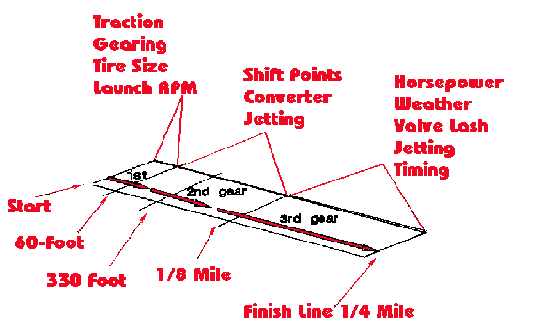
Analyzing your time slip
Are you getting the most benefit out of the drag strip time cards? If your track uses state of the art timing equipment like the "Compulink System", you are provided plenty of data. But how can you use this data? Most race tracks provide you with an elapsed time, trap speed and reaction time. But in 1988, most tracks started using multiple timers that provide 60 foot, 1/16 mile (330 ft.), 1/8 mile (660 ft.) and 1000-foot times also. The newer systems measure the trap speed differently from the old (pre-1988) systems. In the old (NHRA) system, a light beam was placed 60 feet in front of the finish line and 60 feet after the finish line. The computer would calculate your average speed through this 120 foot region. To get a true trap speed, you had to stay on the throttle until you cleared the last light.
Today, the trap speed is measured with two light beams only 60 feet apart. A light beam is placed 60 feet in front of the finish line and the finish line is the last beam.
Use the 60 foot, 660 foot and 1/4 mile elapsed times for evaluating each run. The 60-foot time is dependent upon traction, gearing, launch rpm and staging depth. It varies little with day-to-day horsepower changes. The 60-foot times can vary by .02 sec. during the evening and up to .15 sec. between a hot track and a cool track (with a leaf spring suspension and 10" tire) or as little as .03 all day on a car with 4-link and 14" tires).
The 1-2 shift occurs beyond the 60-foot mark and 2-3 shift occurs before the
660 foot (1/8 mile) point. If you subtract the 60-foot time from the 660-foot
time, you will see how well your car is pulling through the gears. I call this
the "1st-2nd" figure. The difference between 60-foot & 1/8 mile will be good
indication of the proper shift points and whether you are operating in the proper
torque range. This value with vary with amount of horsepower production, shifts
or weather (headwind, barometer). 
The 3rd gear pulls through the remaining 1/8 mile. Take the 1/4 mile elapsed time and subtract the 660 foot time. I call this calculation the "3rd" figure. This is a long pull showing brute horsepower which encounters variables like wind, density altitude (temperature, humidity and barometer) and aerodynamic drag. Changes in jetting, valve lash, ignition timing, etc. show up on this calculation.
The difference between the 1/4 mile ET and the 1/8 mile (660-foot) ET will vary greatly with a head or tailwind. Take calculations of this figure during time trials and compare to past races where there was no wind to figure out how much effect (in ET) the wind has on your car. Then if the wind dies down for first run, you'll know how much to lower your dialin, while everyone else breaks out.
Breaking these figures down into 60-foot, 1st-2nd, & 3rd encourages more research and development. Let's suppose you've increased the shift points by 200 rpm and you notice the ET dropped .05 sec. You think you're on the right track until you notice the 60-foot time went from 1.69 to 1.64 sec. Unfortunately, the .05 sec. was not the result of a changed shift point. It was due to a sudden "gain" in traction! The shift point had no effect! The 60-foot time is related to the tire's temperature and pressure. Cold tires which have not been run in a while need a lower pressure because the relative increase in pressure during burnout is greater with cold tires.
After enough smoke is off rear tires in water box and line lock is released, you have two choices for proceeding: (1) spin out of the water and continue up to the line or (2) Stop the car, roll forward and due two extra burnouts as approaching the line. Tire manufacturers frown on the extra burnouts. They say that the first launch will be the best after the waterbox.
The remaining part of the run after 60-foot time will closely follow the Density Altitude (D/A). The D/A makes only a fraction of a difference in the first 60-feet. Keep track of D/A for each run. With a common 60-foot time calculated for each, you should be able to predict your next run.
The most difficult time to pick a dial-in is during sundown because everything is changing. Keeping records from week to week will help iron this out. Here are some of the variables.
There are many variables involved in racing a car. When you are testing at the dragstrip, be on the lookout for anything causing a reduction of horsepower. You may need to optimize something else first. This is in response to changes made with jetting, timing, valve lash, staging depth, tire pressure, ladder bar adjustments, etc. If you experience several weeks of losing first round, you must review what you have been doing wrong.